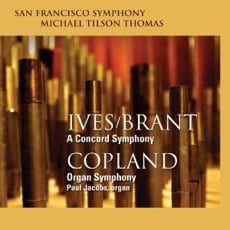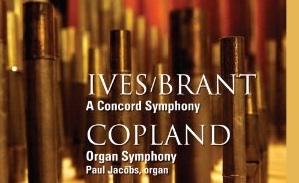
It’s pleasing for a great orchestra to record the standard repertoire; but it’s more exciting, from an audience perspective, for it to record something you’ve not had the opportunity to hear before. The San Francisco Symphony’s recent release of Henry Brant’s orchestration of the Charles Ives Concord Sonata, coupled with Aaron Copland’s Organ Symphony, is not only an artistic triumph but emblematic of priorities rightly ordered.
Brant (who won the Pulitzer Prize for music in 2002) seems to have spent nearly as much time orchestrating the Concord Sonata as Ives spent writing it. (The elder composer began working on the piece in 1904 and finished his last revision in 1947; Brant started work on his orchestration in the 1950s and completed it in 1994.) But, then, it’s a work that does seem to generate, and reward, that sort of obsessive attention.
Listen To The Music
Ives/Brant: A Concord SymphonyI. Emerson (excerpt)
Ives/Brant: A Concord Symphony
II. Hawthorne (excerpt)
Copland: Organ Symphony
II. Scherzo (excerpt)
Related Article
S.F. Symphony Raises a Sublime Noise
February 8, 2011
Brant doesn’t try to retain the percussiveness and clusteriness of his original; despite the huge ensemble, some of the work’s edges are inevitably softened by the expansion. But he’s achieved something of a miracle in the process, because the Concord Symphony sounds — no, it feels — like an original orchestral work.
You would never guess, hearing it “cold,” that it had ever been anything else. Following the piano score while listening fascinated me. Lines are moved to different registers, dispersed among several instruments, sometimes simplified or changed, yet the gist is the same, and every change makes sense in an orchestral context.
The orchestration is vibrant, varied, always to the point, often unexpectedly witty. The scoring of the marching-band episode in the “Hawthorne” scherzo you might expect; the shrill burst of E-flat clarinet and piccolo just afterward, maybe not. And the swirl of elfin mayhem that Brant makes of the opening bars of the same movement is priceless. His “Emerson” (the opening movement) is uncompromisingly craggy and intricate, apart from the places where, as Ives indicates in the score, it goes from “prose” to “verse,” where the tender (relative) simplicity of the score finds its match, again, in the scoring.
The performance is, even for this orchestra, extraordinary. Everyone seems to have invested both energy and care — by which I don’t mean caution, but minute attention. It’s both remarkably intense and remarkably clean playing (there’s usually something of a tradeoff between the two, even in the best of circumstances). The solo woodwind playing, of which there’s naturally quite a lot, is particularly fine.
It does Copland’s 1924 Organ Symphony no great favor to make it follow the Ives/Brant on the disc, but I suppose it was inevitable, given which one ends pppp and which fff. Still, the piece is sufficiently startling. Tilson Thomas had already, some years back, done Copland the service of recording an entire disc of his “modernist” music, and this, with Paul Jacobs the excellent soloist, is another such. The composer whom the listening public at large recognizes — the guy who wrote Appalachian Spring and Billy the Kid and Rodeo — is so small a slice of the actual man that I doubt one in a thousand who hadn’t already heard this work (or any number of others, from Vitebsk to the Piano Variations all the way to the late Connotations) could guess who wrote it. Suffice it to say that it’s consistently interesting, not especially shocking (despite its reputation), and utterly different from the Copland you thought you knew, if you know only the “Americana” phase of his music. Check it out.

